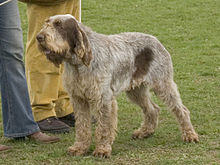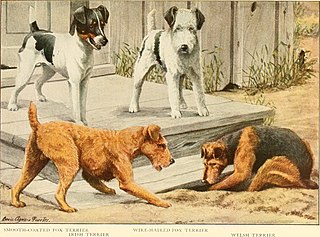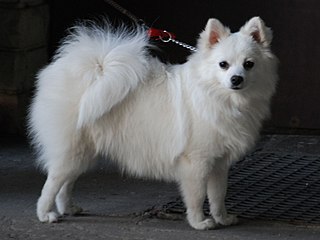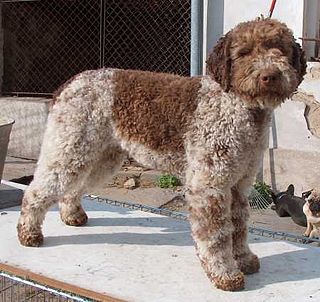| Spinone Italiano | |||||||||||||||||||||||||
|---|---|---|---|---|---|---|---|---|---|---|---|---|---|---|---|---|---|---|---|---|---|---|---|---|---|
 Brown roan | |||||||||||||||||||||||||
| Other names |
| ||||||||||||||||||||||||
| Origin | Italy | ||||||||||||||||||||||||
| |||||||||||||||||||||||||
| |||||||||||||||||||||||||
| Dog ( domestic dog ) | |||||||||||||||||||||||||
The Spinone Italiano [lower-alpha 1] is an Italian breed of hunting dog, traditionally used for tracking, for pointing and for retrieving game. [1] [3] [4] [5]
| Spinone Italiano | |||||||||||||||||||||||||
|---|---|---|---|---|---|---|---|---|---|---|---|---|---|---|---|---|---|---|---|---|---|---|---|---|---|
 Brown roan | |||||||||||||||||||||||||
| Other names |
| ||||||||||||||||||||||||
| Origin | Italy | ||||||||||||||||||||||||
| |||||||||||||||||||||||||
| |||||||||||||||||||||||||
| Dog ( domestic dog ) | |||||||||||||||||||||||||
The Spinone Italiano [lower-alpha 1] is an Italian breed of hunting dog, traditionally used for tracking, for pointing and for retrieving game. [1] [3] [4] [5]

The origins of the Spinone are unknown. [1] : 250 Rough-haired dogs of pointer type have been present in the Italian peninsula at least since the Renaissance. In a fresco painted by Andrea Mantegna in about 1470 in the Camera degli Sposi of the Ducal Palace of Mantua, in Lombardy, in northern Italy, a dog of this kind is shown lying under the chair of the duke, Ludovico III Gonzaga. [1] : 250 Jacques Espée de Sélincourt, in his Le Parfait Chasseur of 1683, says of griffon dogs that "the best come from Italy and from Piedmont". [6] [7] : xxviii
The modern Spinone originated in Piedmont, in north-western Italy, in the nineteenth century and was for some time the most important hunting breed of that region. [1] : 250 During the Second World War it was much used by the partisans, both to track enemies and to carry food. [1] : 250 After the War, breed numbers were much reduced; a breed society, the Famiglia dello Spinone, was formed in 1949, [8] and the breed was reconstituted from about 1950 onwards. [9] The Spinone was definitively accepted by the Fédération Cynologique Internationale in 1955. [10] A second breed society, the Club Italiano Spinoni, was established in 1973. [8]
In the period from 2010 to 2018, new registrations in Italy varied from about 400 to about 650 per year; in every year, the orange-and-white colouring represented slightly over half of the total. [3]
The Spinone is roughly square in outline when seen from the side – the length of the body is approximately equal to the height at the withers. It is a strong, well-muscled and solidly-built suitable for hunting over any kind of ground. It swims well and enters cold or deep water without hesitation. [9]
The coat is rough, thick and flat, with little undercoat; it is about 4 to 6 cm (1.5 to 2.5 in) long, rather shorter on the head, feet and front of the legs. Hair on the eyebrows and lips is longer and stiffer, thus forming a thick moustache and beard. [6] It may be: solid white; white with orange speckling or markings; white with chestnut brown markings; or brown or orange roan. [6]
A Spinone usually lives for about twelve or thirteen years. [1] : 250 Neurological disorders that have been identified in the breed include cerebellar abiotrophy [11] : 308 and idiopathic epilepsy. [12]

The Italian Greyhound is an Italian breed of small sighthound. It may also be called the Italian Sighthound.

The Pharaoh Hound or Kelb tal-Fenek is a Maltese breed of hunting dog. It is traditionally used for rabbit-hunting in the rocky terrain of the islands; the Maltese name means "rabbit dog".

Terrier is a type of dog originally bred to hunt vermin. A terrier is a dog of any one of many breeds or landraces of the terrier type, which are typically small, wiry, game, and fearless. Terrier breeds vary greatly in size from just 1 kg (2 lb) to over 60 kg and are usually categorized by size or function. There are five different groups of terrier, with each group having different shapes and sizes.

Griffon is a type of dog, a collection of breeds that were originally hunting dogs. There are three lines of the griffon type recognized by the Fédération Cynologique Internationale (FCI): the Griffon Vendéens, the wirehaired pointers, and the smousje. The griffon type is characterized by rough- or wire-hair.

The Bergamasco Shepherd, Italian: Cane da Pastore Bergamasco, is an Italian breed of sheepdog. It originated in the Alpi e Prealpi Bergamasche, where it was used as a herding dog for both sheep and cattle.

A kennel club is an organization for canine affairs that concerns itself with the breeding, showing and promotion of more than one breed of dog. Kennel clubs became popular in the mid 19th century. All-encompassing kennel clubs are also referred to as 'all-breed clubs', although "all" means only those breeds that they have decided to recognize, and "breed" means purebred dogs, not including dog hybrids and crossbreeds or mixed-breed dogs. A club that handles only one breed is known as a breed club.

The Cane Corso is an Italian breed of mastiff. It is usually kept as a companion dog or guard dog; it may also be used to protect livestock. In the past it was used for hunting large game, and also to herd cattle.

The Volpino Italiano or Volpino is an Italian breed of dog of Spitz type. It is closely related to the Pomeranian and to the German Spitz.

The Lagotto Romagnolo is an Italian breed of dog. It originates in the marshlands of the Delta del Po in the eastern part of the Romagna sub-region of Italy. The name derives probably from the term “lagotto” which is the name of the inhabitants of the local town of Lagosanto. Another theory believes it comes instead from Romagnol can lagòt, meaning "water dog". Its traditional function was as a gun dog, specifically a water retriever; since the drainage of large areas of wetland habitat in its area of origin, it is now more often used to hunt for truffles.

The Rafeiro do Alentejo is a Portuguese breed of livestock guardian dog. It is named for its area of origin, the Alentejo region of southern Portugal. It is recognised by the Clube Português de Canicultura, and was definitively accepted by the Fédération Cynologique Internationale in 1954.

The Cirneco dell'Etna is an Italian breed of hunting dog from the Mediterranean island of Sicily. It is named for the Etna volcano in eastern Sicily. It has a keen sense of smell, and is used to hunt small game, particularly rabbits. As with many working dogs, registration is conditional on successful completion of a working trial.

The Bracco Italiano is an Italian breed of pointing dog.

The Segugio Italiano is either of two Italian breeds of dog of scent hound type, the wire-haired Segugio Italiano a Pelo Forte or the short-haired Segugio Italiano a Pelo Raso. Apart from the coat type, they are closely similar, and in some sources may be treated as a single breed; the Fédération Cynologique Internationale and the Ente Nazionale della Cinofilia Italiana treat them as separate. They are also genetically close to the other two Italian scent hound breeds, the Segugio Maremmano and the Segugio dell'Appennino. They are traditionally used for hunting hare, but may also be used in boar hunts.

The Neapolitan Mastiff or Mastino Napoletano is an Italian breed of large dog of mastiff type. It descends from the traditional guard dogs of central Italy. It was recognised as a breed by the Ente Nazionale della Cinofilia Italiana in 1949, and accepted by the Fédération Cynologique Internationale in 1956.

The Rastreador Brasileiro is a large breed of dog from Brazil, first recognised by the Fédération Cynologique Internationale in 1967, but an outbreak of disease, compounded by an overdose of insecticide, wiped out the breed's entire breeding stock. The FCI and the Brazilian Kennel Club then declared the breed extinct in 1973 and delisted it. Since then, efforts have been made to re-create the breed. The Rastreador Brasileiro is a hunting dog of the scenthound type. The breed is also known by the names Urrador or Urrador Americano, in reference to the American (U.S.) coonhounds in its background. In 2013, the Brazilian Kennel Club (CBKC) officially re-recognized the breed. The FCI Breed Standard was produced in 2019.
The Segugio dell'Appennino or Piccolo Lepraiolo Italiano is an Italian breed of small scenthound, bred specifically to hunt hare. It may be either smooth-haired or wire-haired. It is one of four Italian breeds of scenthound, the others being the Segugio Italiano a Pelo Forte, the Segugio Italiano a Pelo Raso and the Segugio Maremmano. It received full recognition from the Ente Nazionale della Cinofilia Italiana in 2010; it is not recognised by the Fédération Cynologique Internationale.

The Segugio Maremmano is an Italian breed of scent hound from the coastal plains of the Maremma, in Tuscany. It is mainly used for hunting wild boar, but may also be used to hunt hare and other mammals. They may be either smooth-haired or rough-haired.

The Ente Nazionale della Cinofilia Italiana, usually known as the ENCI, is the national organisation responsible for the recognition, standardisation and registration of pedigree dogs in Italy. It is sometimes called the Italian Kennel Club.
Confederação Brasileira de Cinofilia or CBKC is a Brazilian kennel club confederation based in Rio de Janeiro. The confederation is affiliated with the Fédération Cynologique Internationale (FCI), being the only representative of this system in Brazil.